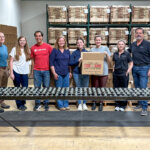October 15, 2024
What Is Utility-Scale Solar? An Overview
Utility-scale solar is crucial to powering a sustainable, affordable energy future. Discover the benefits of solar energy and how utility-scale solar projects are constructed.

Solar panels are increasingly common in neighborhoods across the U.S. According to the Solar Energy Industries Association (SEIA), residential solar installations are expected to power more than 15% of homes in the country by 2030.
Yet, as significant as these rooftop installations are, they only provide a fraction of solar energy needed to substantially reduce harmful emissions from electricity generation, while diversifying our energy mix to enhance security, increase reliability, and lower electricity costs. To truly move the needle, the U.S. needs more utility-scale solar projects throughout the country.
What Is Utility-Scale Solar?
Utility-scale solar projects are large solar facilities, much larger than commercial or residential solar installations, and are typically ground mounted on support posts. They create centralized electric supply facilities that generate solar power and feed it into the electric grid — similar to traditional power plants except without burning fuels to create electricity. Utility-scale solar has been generating reliable electricity for decades and provides stable, cost-competitive electricity for businesses and consumers.
Benefits of Utility-Scale Solar Energy
Utility-scale solar projects bring a wide range of benefits to individuals and communities. Notable advantages of solar energy include:
- Diversified energy mix: expanding solar-generating capacity improves America’s ability to produce homegrown renewable energy. Less reliance on outside energy sources leads to a more resilient, secure energy infrastructure.
- Improved environmental health: the process of solar generation produces no carbon emissions, making it one of the best options for producing electricity. Recent studies have found that renewable energy is delivering concrete health benefits and avoiding premature mortalities from air pollution.
- Affordability: the International Renewable Energy Agency (IRENA) now confirms that solar energy is the cheapest source of power. When combined with energy storage, solar panels can generate and store power for use overnight or during peak-demand times, further driving down electricity costs.
- Job creation: the solar industry boosts the local economy by employing more than 279,000 Americans to develop and construct solar projects.
How Does Utility-Scale Solar Differ From Distributed Generation Solar?
Distributed generation solar includes “behind-the-meter” installations that are primarily designed to provide electricity to individual homes or businesses where they are installed.
In contrast, utility-scale installations provide a minimum of 25 megawatts (MWdc) of solar energy annually — all of which goes directly to the grid. The entire U.S. could be powered by utility-scale solar occupying just 0.6% of the nation’s land mass, according to research from the National Renewable Energy Laboratory (NREL), which is roughly the same area currently used for surface coal mining.
Utility-scale solar and distributed generation solar are both crucial components to adding renewable energy to mix. These solar installations work in tandem to power more than 35.8 million U.S. homes. Utility-scale solar accounts for roughly 71% of that total capacity.
Who Owns and Operates Utility-Scale Solar Projects?
Utility-scale solar installations can be owned by various entities including independent power producers like Arevon, along with utility companies.
Arevon’s projects are funded with private capital and then most are owned and operated and by our company. Arevon typically contracts with offtakers who purchase the renewable energy through a power purchase agreement (PPA).
Who Buys the Energy?
Utility-scale solar generated electricity can be sold to utility companies such as MCE to provide energy to their customers, corporations such as Meta to power their business operations, as well as other entities. These buyers can procure solar energy directly or in the form of renewable energy credits (RECs).
Utility-Scale Solar Project Timeline and Process
The assessment and planning process of a utility-scale solar facility, including site selection, permitting, design, and optimization, generally takes five to 10 years with involvement of the utility provider, permitting agencies, landowners, and local community. From there, site preparation and installation typically take between 12 and 18 months before the project is operational.
Role of Power Purchase Agreements
PPAs are integral to the success of utility-scale solar projects. In these long-term contracts, a buyer agrees to buy energy or RECs from the solar facility at a fixed rate or formula. PPAs provide price predictability for the buyer and revenue stability for the owner.
Utility-Scale Solar Construction
Utility-scale solar construction takes place predominantly in areas of open land with little to no obstructions, ample sun exposure, and access to transmission infrastructure. Site preparation typically includes installing stormwater management and erosion control measures, grading the land, re-seeding soil, controlling weeds, building interior roads, and any other site-specific activities needed for the project. These steps ensure the land is stable, environmentally controlled, and ready for construction.
Construction involves installing steel posts, called piles, in the ground, onto which racking and solar panels are then installed. Construction crews must also add inverters to convert direct current (DC) solar energy into usable alternating current (AC) power. Finally, a fenced-in substation serves as the main center of operations and connection to the grid.
Long-Term Impact and End of Life
The typical utility-scale solar project has a lifespan of 35 to 40 years. During that time, the facility disburses predictable revenue for landowners and generates reliable, homegrown solar energy for utilities and corporate customers.
A typical 100 MW solar facility generates enough electricity to power 17,200 average U.S. homes. Over its lifespan, the project will generate 95% fewer emissions than a similar coal-fired power plant, according to data from the NREL.
Solar projects also protect land from urban sprawl and industrialization. According to the American Farmland Trust, America loses 2,000 acres of farmland to low-density, inefficient urban sprawl each day. This kind of development is permanent, unlike solar where the land can be returned to its original use at the end of the life of a project.
At the end of a project’s life, an owner-operator like Arevon would remove all equipment, recycle the panels, and restore the land to its original condition.
Advancing Solar Energy: A Path to a Sustainable and Resilient Grid
Utility-scale solar is integral to powering the energy transition by reducing reliance on fossil fuels and providing sustainable, homegrown power to the grid.
Arevon is a leading renewable energy company, supplying reliable, cost-effective energy to utilities and businesses. We develop, build, finance, own, and operate renewable energy projects across the country. Contact us today if you have questions or wish to speak with an energy expert.
Explore Utility-Scale Solar Frequently Asked Questions



